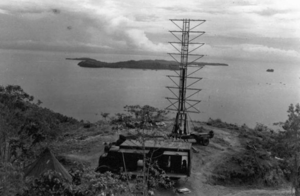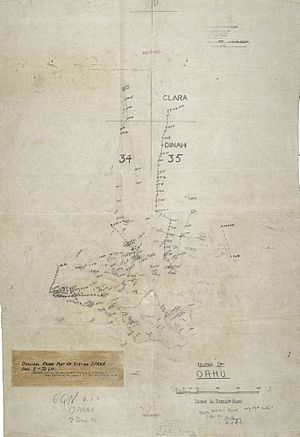Radar warning of Pearl Harbor attack facts for kids
On the morning of December 7, 1941, a new radar system on the island of Oahu in Hawaii picked up something big. It showed many airplanes flying towards the island from the north. This important message was sent to a place called the Intercept Center at Fort Shafter. However, a Lieutenant named Kermit Tyler thought it was just a group of American planes arriving on schedule. He was wrong. The radar had actually spotted the first wave of planes from the Imperial Japanese Navy Air Service that were about to attack Pearl Harbor.
Contents
The Pearl Harbor Attack
On December 6, 1941, Private Joseph P. McDonald started his work shift at 5:00 AM. He was at the Intercept Center at Fort Shafter. This center was where the US Army Air Corps (USAAC) watched for planes using a new technology called radar. There were five radar systems placed around Oahu. For several weeks, the people at the Intercept Center had been very alert. This was because military leaders could not find out where the Imperial Japanese Navy was.
At 4:00 AM on December 7, 1941, USAAC radar operators came to work their shift. They were supposed to work from 4:00 AM to 7:00 AM. After they left the Intercept Center at 7:00 AM to eat breakfast, Private McDonald stayed at his post. He waited for his friend, Private Richard Schimmel, to come back from breakfast and take over.
Radar Operators' Discovery
Also at 4:00 AM, U.S. Army Private Joseph Lockard and his friend, Private George Elliott, were working. They were at the Opana Radar Site, using a special radar called an SCR-270. Lockard was the main radar operator. Elliott helped by marking things on a map. Since November 27, 1941, Lockard and Elliott had been working from 4:00 AM to 7:00 AM. This was a change from their usual schedule. The United States Department of War had warned about a possible Japanese attack. This warning caused the change in their work hours.
At 7:02 AM, Lockard and Elliott saw a huge group of planes on their radar screen. Lockard was more experienced with radar than Elliott. He thought it was very strange to see 180 planes show up. They detected the planes about 132 miles away. This was almost at the edge of their radar's 150-mile range. They were surprised by the strong signal. They checked and made sure the radar was working correctly.
Lockard then tried to call his boss, but he could not reach him. Elliott called the Intercept Center at Fort Shafter instead. McDonald answered the phone. Elliott asked for the map plotters. McDonald said the plotters had left. Elliott then warned him that many planes were heading towards Hawaii from the north. McDonald thought he was the only one left at the center. He told Elliott he did not know what to do. Suddenly, the phone call ended.
A Warning Ignored
After checking the time, McDonald saw Kermit Tyler, a USAAC Lieutenant, sitting at a table. McDonald told Tyler about the call from Opana. Tyler was new to the Intercept Center. It was only his second day working there. He did not think the report was important.
McDonald went back to the phone and called Opana again. This time, he reached his friend, Lockard. McDonald told Lockard that Tyler did not seem worried. Lockard was more upset than Elliott. He warned McDonald that a large number of planes were quickly heading to Oahu. He said they covered the entire radar screen.
McDonald kept Lockard on the line and went back to Tyler. He told Tyler how urgent Lockard's voice sounded. Tyler thought it was probably a group of B-17 planes coming from the United States. Lockard then asked to speak directly with Tyler. When Lockard warned Tyler again about the planes, Tyler told Lockard, "Don't worry about it." After Tyler ended the call with Lockard, McDonald asked Tyler if they should call the map plotters or Wheeler Field. Tyler again said, "Don't worry about it."
McDonald believed Lockard's report. He wanted to call Wheeler Field. But he was worried he would get in trouble for going around Tyler. At 7:45 AM, McDonald's replacement arrived, and McDonald's shift ended.
Lockard and Elliott watched the planes on the radar until 7:40 AM. Then the signal was lost because of interference from the mountains. Around 7:45 AM, Lockard turned off his radar. He then went back to his base for breakfast.
McDonald was tired from working a long shift. He decided to call Wheeler Field from a tent near his own, which overlooked Pearl Harbor. But the Sergeant in that tent was using the phone. McDonald went back to his tent. He warned his tent mate, Schimmel, that the Japanese were coming to Oahu. Moments later, McDonald and Schimmel heard a loud noise. It meant a large group of planes had arrived. Around 7:50 AM, they saw Japanese planes attacking Pearl Harbor and Hickam Field.
After the Japanese attack began, McDonald and Schimmel were called back to the Intercept Center. Schimmel found McDonald's message from Elliott crumpled up in a trash can. Before officials took the message for an investigation, Schimmel copied it word-for-word. He wrote it in a notebook with the date "December 7, 1941" and the words "a great number of planes coming in from the north."
After the Attack
After the attack, officials interviewed McDonald as part of their investigation. U.S. Supreme Court Justice Owen Roberts told McDonald that his warning to Tyler was very important. Colonel W.H. Tetley, a commanding officer, praised McDonald's efforts. He said that if Tyler had told the Fighter Wing, they might have been able to get planes in the air. This could have reduced the attack's impact and saved lives and equipment.
On February 1, 1942, an Associated Press article shared Lockard's story with the American public. It told how he "detected Japanese planes approaching Pearl Harbor" but his warning was not listened to.
In August 1942, a group called the Naval Board of Inquiry looked into the situation. They found that Tyler had been sent to the Intercept Center with little training. He also had no one to supervise him and no staff to work with. They decided that Tyler had done nothing wrong and did not punish him.
Who Were the Key People?
Lockard was promoted to Staff Sergeant. He also received the Distinguished Service Medal. He then went to a special school to become an officer. He became a Second lieutenant in the U.S. Army Signal Corps. After more radar training, he worked as a radar officer on Adak and Amchitka Islands for the rest of the war. After the war, he worked for several companies and got over 35 patents for his inventions. He passed away on November 2, 2012.
McDonald served in the central Pacific during the war. He worked at places like Kanton, Makin, Kwajalein, Guadalcanal, New Guinea, and Saipan. After the war, he worked at Pratt & Whitney for 20 years. He passed away on August 7, 1994. On November 29, 2005, he was given the Army Commendation Medal after his death. This was for his efforts to warn his leaders about the Japanese attack. McDonald's son, George, accepted the award for his family.
Tyler continued to serve in the military. He retired as a United States Air Force Lieutenant colonel in 1961. He passed away on February 27, 2010.
In Movies and Books
The story of the radar warning has been shown in many books and movies. These include Walter Lord's Day of Infamy, At Dawn We Slept by Gordon Prange and Donald M. Goldstein, the movie Tora! Tora! Tora!, and the movie Pearl Harbor.



